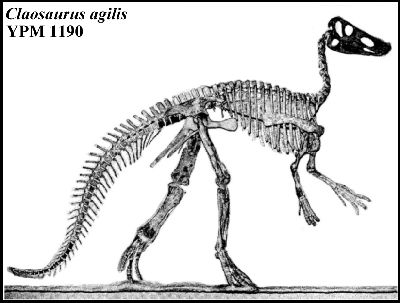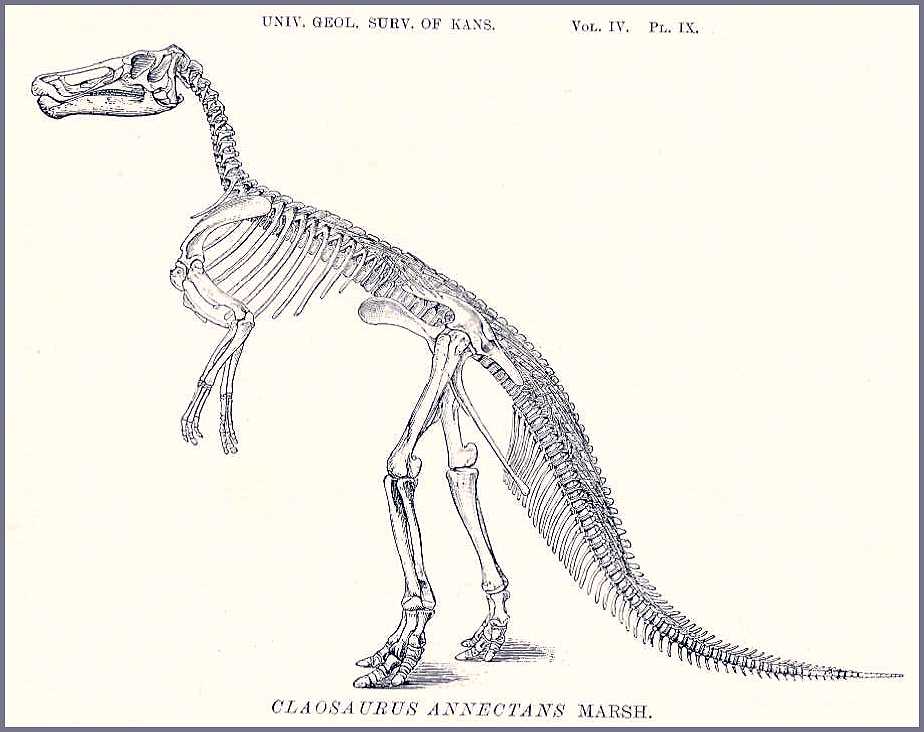 |
The first dinosaur from the
Niobrara Chalk
Marsh, O. C., 1872.
Notice of a new species of Hadrosaurus.
American Journal of Science, Series 3, 16:301
Copyright © 2002-2009 by Mike Everhart
Last updated 02/14/2009
LEFT: The mounted type specimen of Claosaurus
agilis (YPM 1190) in the Yale Peabody Museum. |
Wherein, O. C. Marsh recounts the discovery of the remains of a
dinosaur from the chalk of western Kansas. According the Carpenter, et al. (1995), these
remains were found by Marsh about four miles east of present day Russell Springs, Kansas,
on the north side of the Smoky Hill River. Marsh later (1890) changed the genus name to Claosaurus
("broken lizard") when major differences between it and Hadrosaurus
became apparent. The remains found in Kansas indicated a 12 to 15 foot long animal.
301
II. Geology and Natural History.
1. Notice of a new species of Hadrosaurus; by
O. C. MARSH. Among the Reptilian remains obtained by the Yale College party
during the past summer [1871] was the greater part of a skeleton of a small Hadrosaurus,
discovered by the writer in the blue Cretaceous shale near the Smoky Hill River, in
Western Kansas. This species was somewhat smaller than H. minor Marsh, from New
Jersey, and hardly more than one-third the bulk of H. Foulkei of Leidy. It was of
more slender proportions, with the tail much elongated. The cervical vertebra are
proportionally shorter than in H. Foulkei, and the caudals appear more compressed,
Some of the distal caudals have a longitudinal ridge on the lateral surface. The sacrum,
which is composed of six confluent vertebrę is 414 mm. in length. The first caudal
vertebra is 62 mm. in length. The feet are nearly entire, and are proportionally more
slender than the known remains of the other species would indicate. The third metatarsal
is 235 mm. in length, and 77 mm. in transverse diameter at its distal end. This species,
which may be called Hadrosaurus agilis, will be fully described in this Journal at
an early day.
Yale College, New Haven, March 19th, 1872.
(See Kansas 1872 map HERE) |
See more on recent discoveries of Kansas dinosaurs HERE
and HERE
For a further discussion of this specimen and Kansas dinosaurs in general, see:
Carpenter, K., D. Dilkes, and D.B. Weishampel, 1995. The dinosaurs of the
Niobrara Chalk Formation (upper Cretaceous, Kansas), Jour. Vert. Paleon. 15(2):275-297.
Everhart, M.J. and Hamm, S.A. 2005. A new nodosaur specimen (Dinosauria:
Nodosauridae) from the Smoky Hill Chalk (Upper Cretaceous) of western Kansas. Kansas
Academy of Science, Transactions 108(1/2), p. 15-21.
Liggett, G.A. 2005. A review of the dinosaurs from Kansas. Kansas Academy of
Science, Transactions 108(1/2), p. 1-14.
Marsh, O.C. 1890. Additional characters of the Ceratopsidae, with notice of new
Cretaceous dinosaurs. American Journal of Science, Series 3, 39, p. 418-426, with pls.
v-vii.
Williston, S. W., 1898. Dinosaurs. The University Geological Survey of Kansas, Part
III, 4:67-70, pl. 9.
The picture below shows a related species of hadrosaur discovered
by O. C. Marsh in Wyoming. Earl Manning notes (pers. comm, May, 2003) that "Hadrosaurus"
annectens is now considered to be a primitive hadrosaurine called Edmontosaurus.




